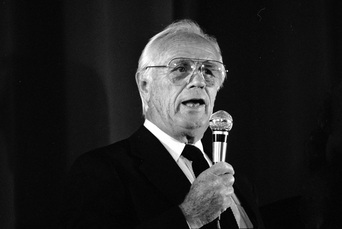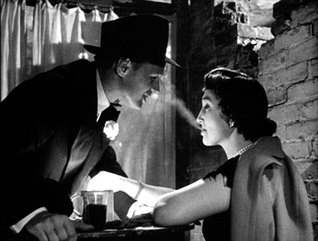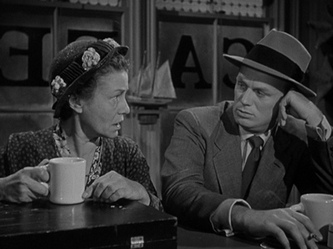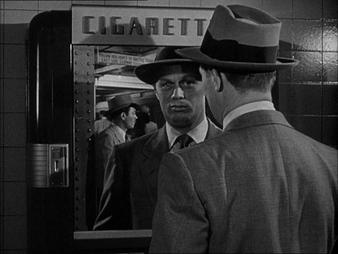
Most people know Richard Widmark as the psycho who threw an old lady in a wheelchair down a flight of stairs in the classic film noir Kiss of Death. But Widmark had a long and lively career, and on his resume are two of the greatest crime dramas ever made.
The first is Jules Dassin's Night and the City. (The original, not the horrid 1990's remake.) Night and the City tells the tale of Harry Fabian, a low-rent London club promoter with dreams of making it big. Fabian's chance comes when he meets Gregorious, an aging wrestler. See, wrestling is massively popular in London at the time, but it's the staged wresting we know today. Gregorious is appalled and wants someone to stage real, traditional wrestling matches without all the fakery. Fabian decides he's going to become a wrestling promoter and throws in with Gregorious.

See, Gregorious is Kristo's estranged father. Kristo is desperate to earn his papa's respect, and with Gregorious on his side, Fabian can't be touched.
All this adds up to a grimy stew of tragic brutality that must be witnessed to be believed. Widmark's manic-depressive performance is the film's spine.
Dassin was a remarkable filmmaker, and the final sequence of Night and the City which runs almost ten minutes proves it. The sequence has Fabian on the run from the bad guys. He flees across a bridge, confronts his girlfriend in a fishing shack, runs out again, back on the streets for the final show-down with Kristo's baddies.
The kicker, it all takes place at dawn.
This may not seem like a big deal, but dawn is a fleeting thing. There are only about twenty minutes before the sun comes up when you have enough light to film. And this is 1950's technology we're talking about.
The producers immediately flagged this sequence as a problem, calculating it would take Dassin twenty days of dawn shooting to film the entire sequence at dawn, way too much time for a movie of such a modest budget. Dassin had another idea and informed the producers he would shoot the sequence in two days. One day to rehearse, and one day to shoot.
What he did was employ six cameras and six crews. The six cameras were placed in six different positions to capture the first six beats of the sequence. But since the entire sequence encompasses more than six positions, they had to leap-frog.

And of course, each other camera does the same thing, leap-frogging from position to position so the entire sequence can be filmed seamlessly.
And seamless it was. After a day of rehearsal, the scene was filmed live, no stops, no breaks. Widmark started running and didn't stop until the final shot of the film. Most impressive of all, they did it in one take. If you've worked on films, you'll understand how daunting a technical and acting challenge that is. The raw energy of it makes it one of the most dynamic sequences in all of film noir.
Widmark's other classic is Sam Fuller's Pickup on South Street. Fuller is one of the greatest low-budget auteurs of all time. The film he is best known for is the brutal, blackly comic The Big Red One, starring Lee Marvin, Robert Carradine and Mark Hamill. (A recent re-release with numerous deleted scenes put back in is an interesting exercise in restoration. Half the new scenes are so brilliant you wonder how the film could have existed without them, and half are so weak you completely understand why the editor pulled them out the first time.)
Fuller had served in World War II, hitting the beaches in Africa, Sicily and Normandy. His war experiences inform every film he ever made.
If you want to understand Fuller, check this story out: Fuller was filming Fixed Bayonets, a Korean War drama. He's staging a scene where a group of GIs are getting mortared. Fuller shows his actors where the first explosive is planted. He tells them that when he called "number one" the first explosive will go off. The men will then run to their right. He will call "number two" and the second explosive will go off.

He yells "number two!" and detonates bomb number six. In seconds, the actors are running for their lives as explosives go off at random. For Fuller, this was the only way to capture the horror and chaos that is war. Or as he once put it, "the only way you could ever convey the terror of war to an audience would be to have someone shooting at them."
Pickup is a crime drama from 1953 in which Widmark plays Skip McCoy, a low-life pickpocket who accidentally becomes involved with a Communist plot to steal weapons technology.
Fuller revels in the quirky characters who populate New York City's underworld. Most memorable is Thelma Ritter as Mo, the necktie-selling informant who's goal is to save enough money to buy herself a nice burial plot.
The movie is not only remarkable for its characters, but its dialogue. It may be the most quotable movies ever with gems like:
"Everybody likes everybody when they're kissing."
"What do I know about commies? Nothing. I know one thing. I just don't like them."
"I have to go on making a living so I can die. But even a fancy funeral ain't worth waiting for if I've gotta do business with crumbs like you."
Combine all that with a terrific story of crime and espionage and you have a winner, especially when you throw Widmark in as Skip McCoy. Widmark's performance is a joy, wise-cracking, cynical, yet with a heroic center.
Fuller was known for firing a blank pistol in lieu of calling "action" at the head of a take. The loud sound startled his actors and made them uneasy, an effect he loved. After he did this the first time on Pickup, Richard Widmark went up to him, took the pistol away and said "we're not going to do that anymore, are we?"
He didn't.
So the math is simple: Widmark + Fuller = perfection.

 RSS Feed
RSS Feed
